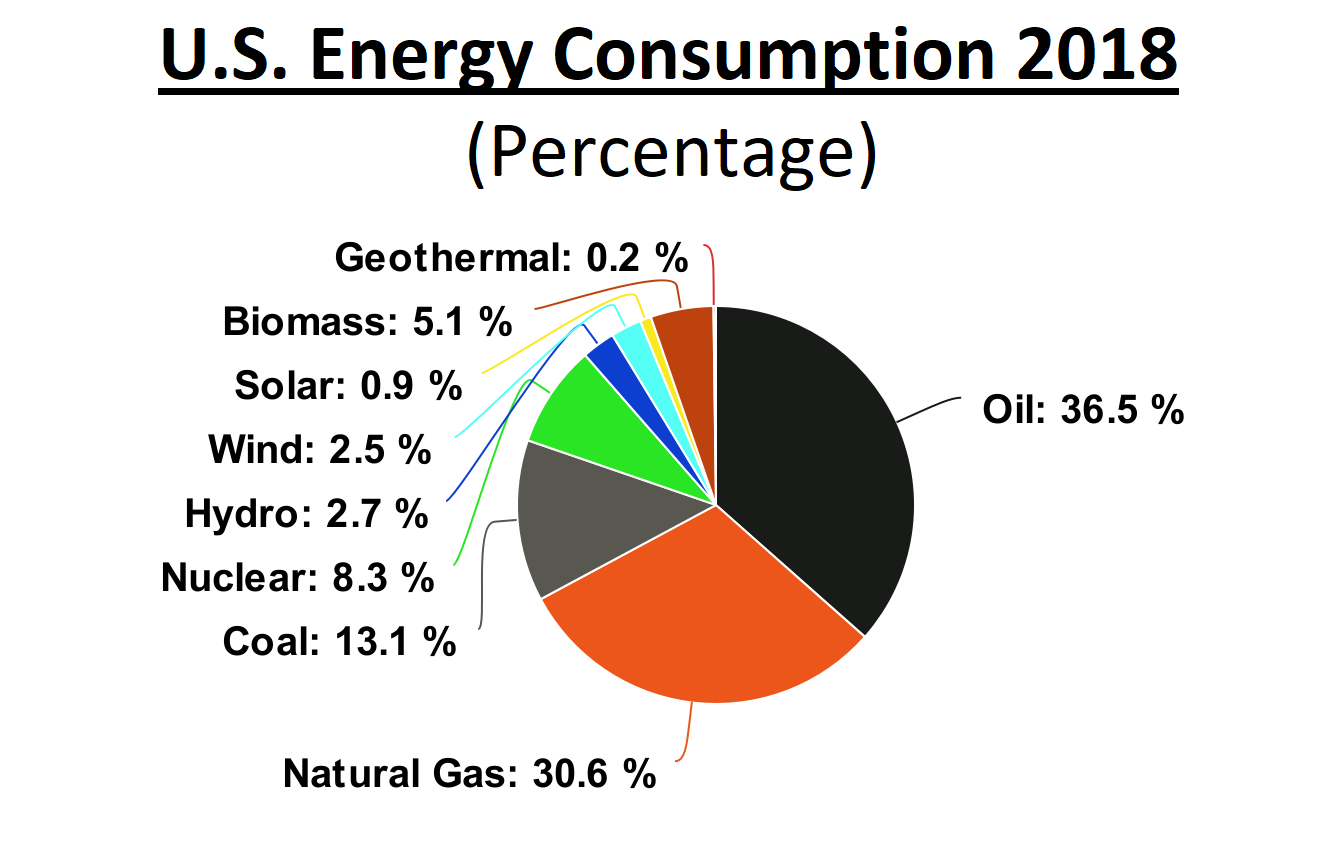With a booming economy, the United States consumed a record high of 101.3 quadrillion Btu of energy in 2018–3.5 percent higher than the 97.8 Btu consumed in 2017 and 0.3 percent higher than the previous energy consumption record in 2007. Of the energy consumed in 2018, fossil fuels (coal, oil, and natural gas) represented an 80 percent share, and their combined consumption was 4 percent higher than in 2017. Nuclear power contributed 8 percent, and renewable energy, including hydroelectric power, contributed 11 percent to total energy consumption in 2018. Renewable energy consumption was 3 percent higher than in 2017.

Natural Gas
Natural gas consumption reached a record high of 30.96 Btu in 2018—increasing by over 10 percent from consumption levels in 2017. All sectors increased their consumption of natural gas, driven primarily by weather-related factors that increased demand for space heating during the winter and for air conditioning during the summer. As natural gas generation continued to replace coal generation, its consumption in the electric power generating sector increased 15 percent from 2017 levels. Natural gas consumption also increased in the residential sector (by 13 percent), commercial sector (by 10 percent), and industrial sector (by 5 percent) in 2018.
Petroleum
Petroleum consumption increased to 36.9 quadrillion Btu in 2018—increasing 2 percent from consumption levels in 2017. Petroleum consumption increased primarily in the industrial sector, which increased its consumption by 3.6 percent in 2018, mostly of hydrocarbon gas liquids. The transportation sector increased its petroleum use by 1 percent as a result of increased demand for petroleum diesel and jet fuel.
Coal
Coal consumption declined to 13.3 quadrillion Btu in 2018–the fifth consecutive year of decline–and 4 percent lower than consumption in 2017. Electric power sector consumption of coal–the greatest user of coal–declined by 4.3 percent from 2017 levels. Coal-fired power generation continued to be displaced by natural gas and renewable power generation in 2018, as 12.9 gigawatts of coal-fired capacity were retired, while 14.6 gigawatts of net natural gas-fired capacity were added.
Nuclear
Nuclear consumption increased by 0.3 percent in 2018 compared with 2017 levels. Despite the retirement of several nuclear units in recent years, nuclear power set a record for its electricity generation in 2018. The Oyster Creek Nuclear Generating Station in New Jersey, which was retired in September 2018, was the most recent nuclear plant to retire. The number of operable nuclear-generating units in the United States is now at 98, with 6 retiring since 2012. The increased generation is a result of higher operating levels for the remaining units. The average nuclear capacity factor increased to 92.6 percent in 2018—slightly higher than its 92.2 percent average in 2017.
Renewable Energy
Renewable energy consumption, including hydroelectric power, reached a record high of 11.5 quadrillion Btu in 2018–increasing 3 percent from levels in 2017. The increase was largely driven by additional wind and solar power generation, followed by increased biomass consumption. Biomass consumption increased 0.9 percent in 2018, primarily in the form of transportation fuels such as fuel ethanol and biodiesel, which accounted for 44 percent of all biomass consumption in 2018. Wind electricity consumption increased by 8 percent and solar consumption increased 23 percent, but combined they represented just 3.4 percent of our energy needs in 2018. Increases in wind, solar, and biomass consumption were partially offset by a 3 percent decline in hydroelectric consumption.
Conclusion
While renewable fuels increased in 2018, combined, they provided only 11 percent of our energy needs. Wind and solar only contributed 3.4 percent despite numerous federal and state subsidies and mandates, requiring their construction and use. Our energy needs were met mainly by fossil fuels—coal, oil, and natural gas—as has been the case for many years. When our economy is growing successfully, energy consumption goes up in order to fuel the growth. The year 2018 is a record-breaker for U.S. energy consumption.